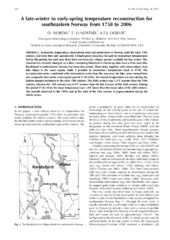A late-winter to early-spring temperature reconstruction for southeastern Norway from 1758 to 2006
Peer reviewed, Journal article
Published version
Permanent lenke
https://hdl.handle.net/1956/3475Utgivelsesdato
2007-10Metadata
Vis full innførselSamlinger
- Department of Earth Science [1050]
Originalversjon
https://doi.org/10.3189/172756407782871657Sammendrag
Systematic temperature observations were not undertaken in Norway until the early 19th century, and even then only sporadically. Climate-proxy data may be used to reconstruct temperatures before this period, but until now there have not been any climate proxies available for late winter. This situation has recently changed, as a diary containing historical ice break-up data from a farm near lake Randsfjord in southeastern Norway has been discovered. These data, together with observations from lake Mjøsa in the same region, make it possible to reconstruct temperature back to 1758. The reconstructed series, combined with instrumental series from the area near the lake, were merged into one composite time series covering the period 1758–2006. The lowest temperatures are seen during the Dalton sunspot minimum in the early 19th century. The 20th century was 1.3°C warmer than the 19th century, whereas the 19th century was 0.4°C warmer than the last 43 years of the 18th century. During the period 1758–1850, the mean temperature was 1.4°C lower than the mean value of the 20th century. The warmth observed in the 1990s and at the start of the 21st century is unprecedented during the whole series.
